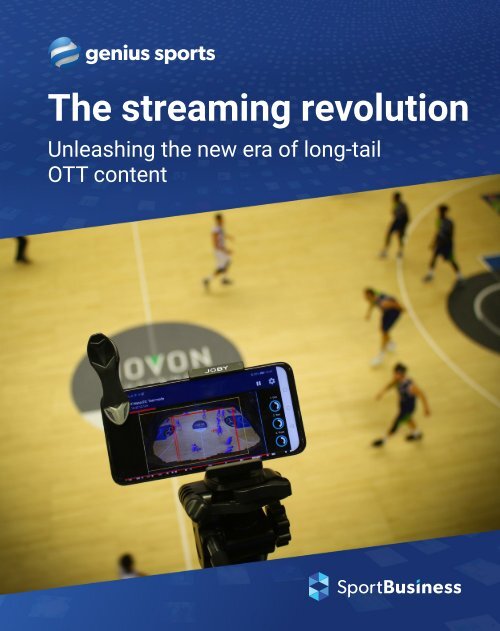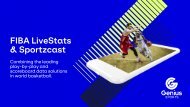Genius Sports Streaming Whitepaper - SportBusiness December 2019
You also want an ePaper? Increase the reach of your titles
YUMPU automatically turns print PDFs into web optimized ePapers that Google loves.
The streaming revolution<br />
Unleashing the new era of long-tail<br />
OTT content
In association with GENIUS SPORTS<br />
It’s time for all sports to grab a piece<br />
of the OTT action<br />
(Lachlan Cunningham/Getty Image)<br />
Like every other significant<br />
business sector, sport is being<br />
driven and shaped by technology.<br />
Historically it had been a largely<br />
linear business, effectively controlled<br />
by major media organisations with the<br />
deep pockets required to buy-up rights to<br />
must-see properties. They made money<br />
either because they had a mass audience<br />
attractive to advertisers or a subscriber<br />
base willing to pay to watch sport.<br />
The inevitable result was that<br />
the media companies became the<br />
gatekeepers to opportunity in sports.<br />
Because they decided what content<br />
was available to the public, they<br />
effectively limited the ability of sports<br />
property owners and governing bodies<br />
to maximise revenues and grow their<br />
sport through re-investing.<br />
Now that’s changing and changing fast.<br />
While the old models may not<br />
be broken, they are certainly under<br />
pressure and the business of sport is<br />
being transformed by tech, creating a<br />
new era of commercial opportunity.<br />
Leading the change are the<br />
OTT platforms, whose technology<br />
allows sports to bypass traditional<br />
media outlets to stream directly to<br />
fans, offering a far wider range of<br />
content at more flexible price points.<br />
And because, unlike traditional<br />
broadcasters, they have a genuine<br />
two-way relationship with viewers,<br />
they accumulate commercially and<br />
strategically valuable data about fans.<br />
Of course the tech giants like<br />
Facebook and Amazon are already<br />
dipping their toes into the waters of<br />
sports, bidding for rights to properties<br />
including the Premier League and<br />
NFL and fuelling competition in those<br />
rarefied markets.<br />
But perhaps the most exciting<br />
disruption is occurring elsewhere, where<br />
innovative OTT players are creating<br />
exposure and opportunity for properties<br />
further down sport’s traditional food<br />
chain. The result is a massive increase<br />
in the volume of content – often<br />
considered niche – available and the<br />
ability for rights-holders to access,<br />
identify and monetise fans who were<br />
previously disenfranchised. The impact<br />
is truly liberating.<br />
The key to all this is the ability for<br />
rights-holders to create, manage and<br />
control their own video content and<br />
technological developments over<br />
recent years have sparked a continuing<br />
revolution in this area. Smartphones,<br />
digital connectivity and artificial<br />
intelligence are combining to make<br />
what was previously a dream a reality.<br />
Costs of production, management<br />
and distribution of video content are<br />
tumbling, providing a platform and a<br />
commercial lifeline to properties which<br />
were previously virtually invisible<br />
beyond the live audience.<br />
The result is that – regardless of their<br />
size, audience, existing tech or digital<br />
infrastructure – leagues can develop<br />
monetisable OTT strategies that were<br />
unimaginable just a few years ago.<br />
The potent combination of automated<br />
production, new video inventory both<br />
live and on-demand and untapped<br />
advertising opportunities make this a<br />
pivotal time for the development of<br />
long-tail sport. The revolution is well<br />
and truly under way and this time,<br />
sports at every level are in control.<br />
By drawing on the expertise of<br />
technology and streaming specialists<br />
<strong>Genius</strong> <strong>Sports</strong>, this special supplement<br />
looks at the opportunities and challenges<br />
for sports launching their first OTT<br />
platforms. <strong>Genius</strong> <strong>Sports</strong> provides<br />
leagues and federations at every level<br />
with automated streaming, production<br />
and OTT solutions and is uniquely<br />
positioned to present the previous<br />
barriers to entry, the rapid technological<br />
shifts and the key questions leagues must<br />
ask in a democratised video landscape.<br />
Introduction by<br />
Kevin Roberts,<br />
Editorial<br />
Director,<br />
<strong>SportBusiness</strong><br />
2<br />
www.sportbusiness.com | TWITTER@<strong>SportBusiness</strong>
Breaking down OTT barriers<br />
<strong>Streaming</strong> live sports is not a new<br />
phenomenon. As far back as September<br />
1995 with live radio coverage of the<br />
Seattle Mariners against the New York<br />
Yankees, sports have been using the<br />
internet to go over the top.<br />
And yet sports streaming and OTT<br />
still resembles an immature sector.<br />
Rapid advancements have been made<br />
in the last five years, with many experts<br />
prematurely predicting the end of TV’s<br />
dominance of live sports consumption.<br />
But even for the largest leagues and<br />
federations, creating, growing and<br />
marketing a successful OTT product is a<br />
largely untested area and the long-term<br />
potential has yet to be unearthed.<br />
For those rights-holders beyond<br />
the top tier, meanwhile, streaming<br />
represents an almighty step into the<br />
unknown. Historically, most have had<br />
to reluctantly accept TV’s ironclad<br />
grip over sport, determining which<br />
competitions are showcased to the<br />
world and which aren’t.<br />
For those sports within the<br />
inner circle, TV’s impact has been<br />
transformational, providing increased<br />
sponsorship, exposure and investment.<br />
While for the broadcasters themselves,<br />
the largest sports have been the jewel in<br />
their crown for decades, attracting the<br />
biggest audiences and billions of dollars<br />
in advertising spend.<br />
The chasm to the top tier of sports<br />
has grown wider. The vast rights,<br />
production and distribution costs<br />
involved for the broadcasters have<br />
dictated that only the largest sports<br />
globally with commercially lucrative<br />
audiences have been able to benefit<br />
from an increasingly imbalanced model.<br />
This has forced many sports to rely<br />
on social media, digital marketing and<br />
other channels to grow and engage<br />
their audience. All are valuable tools<br />
but video, whether by highlights, live<br />
streams or broadcast, is simply the most<br />
powerful means of attracting any fan’s<br />
attention.<br />
Costs of going it alone<br />
Every league, federation and club<br />
wants to be able to provide its fans<br />
with high-quality video content. But to<br />
truly go over the top of television and<br />
directly engage their fans, sports have<br />
historically had to cover the costs of<br />
hardware, specialist personnel and most<br />
significantly, production.<br />
More than 5,800 credentialed media<br />
professionals were required to cover<br />
Super Bowl LIII in Atlanta and while<br />
this clearly isn’t comparable for longtail<br />
sports, it demonstrates the scale<br />
and quality of TV production that the<br />
majority of fans expect.<br />
Even fans of less commercial sports<br />
competitions will expect a reliable,<br />
high-quality stream with integrated<br />
live scores and some more advanced<br />
team and player statistics, providing<br />
essential context to the live action.<br />
And this content has to be delivered<br />
to them on-the-go, across multiple<br />
devices in an engaging format that can<br />
be quickly consumed.<br />
Having a video strategy is essential for<br />
every modern sports organisation. In an<br />
increasingly competitive entertainment<br />
landscape, sports at all levels need to<br />
produce large volumes of content that<br />
will compete for eyeballs across inboxes,<br />
digital advertising space and in particular,<br />
social media. Where once, different social<br />
tools specialised in varying forms of<br />
content (e.g. Twitter for text, Instagram<br />
for pictures) they are all increasingly<br />
dominated by video, both live and ondemand<br />
to attract millennials.<br />
All sports have to recognise and<br />
adapt to this trend but many have<br />
been priced out of launching their<br />
first OTT platform, unable to cover<br />
the implementation, maintenance and<br />
production costs of first-to-market<br />
streaming solutions. OTT though is,<br />
by nature, a prime example of digital<br />
disruption and several market changes<br />
have democratised the streaming<br />
landscape in recent years, opening the<br />
door for sports, of all sizes, to showcase<br />
their video content to the world.<br />
In association with GENIUS SPORTS<br />
TWITTER@<strong>SportBusiness</strong> | www.sportbusiness.com<br />
3
In association with GENIUS SPORTS<br />
Rise of automated production<br />
The most important development in<br />
enabling all levels of sport to stream<br />
their content has been the emergence<br />
of automated production systems.<br />
Being able to automatically track<br />
the live action, identify highlights,<br />
embed statistics and insert adverts<br />
and sponsorship opportunities was<br />
far beyond even the most advanced<br />
streaming solutions five years ago.<br />
But both in and out of sport, the<br />
intervening period has seen huge<br />
progress in the field of artificial<br />
intelligence and computer vision.<br />
Whether by embedded chips in players’<br />
shoes and the ball or advanced motion<br />
sensors to track the flow of play,<br />
democratised tracking technology has<br />
changed the game in sports streaming.<br />
<strong>Sports</strong> of all sizes now have tools at<br />
their disposal that can automatically<br />
track, pan and zoom with every play<br />
while cutting between multiple cameras<br />
positioned around the pitch or court.<br />
These solutions weren’t immediately<br />
perfect: differentiating between major<br />
crowd movements, stitching a highquality<br />
picture together with multiple<br />
angles and ensuring reliable, low<br />
latency streams have all been significant<br />
challenges in the emergence of<br />
automated solutions.<br />
But by eliminating the need for invenue<br />
directors, cameramen and other<br />
production staff, automated production<br />
removes a once insurmountable barrier<br />
to entry. Powered by cloud-based<br />
technology which simplifies how sports<br />
manage and distribute their content<br />
while processing billions of data points,<br />
these solutions are transforming the<br />
production of live sports.<br />
As Mehul Padaia, vice-president<br />
of global marketing at Tata<br />
Communications, told Raconteur last<br />
year: “The cloud is levelling the playing<br />
field between sports giants like F1 and<br />
smaller local series like the F4 British<br />
Championship. You only need a few<br />
cameras to capture the action; the rest<br />
of the production can be done easily and<br />
inexpensively in the cloud.<br />
“This opens up a global market for<br />
local sports leagues … Also, because<br />
producing and distributing content in<br />
the cloud is simpler and less expensive,<br />
it lowers the barriers for smaller sports<br />
organisations.”<br />
Long-tail sports launching their first<br />
OTT platform shouldn’t immediately<br />
expect a TV-level of production. But<br />
automated solutions have opened an<br />
unprecedented window of opportunity,<br />
“Because producing and<br />
distributing content in the<br />
cloud is simpler and less<br />
expensive, it lowers the<br />
barriers for smaller sports<br />
organisations.”<br />
The impact of smartphones on the camera industry<br />
enabling them to showcase their games<br />
for the first time while controlling<br />
when their events are played, how<br />
their video content is delivered across<br />
multiple platforms and the tools they<br />
want to use to enhance every stream<br />
and highlight.<br />
<strong>Streaming</strong>: Smartphones’ next<br />
frontier<br />
On top of the onerous production and<br />
resource costs, to go over the top sports<br />
would historically have to cover the<br />
significant hardware expenditure of<br />
cameras in multiple different venues.<br />
Smartphones, however, have had a<br />
transformative effect on modern sport,<br />
making every league, federation, club<br />
and fan an instant content producer.<br />
Fans rely on their mobile phone to<br />
capture live streams and photos at a<br />
game and quickly consume everything<br />
from odds to scores, highlights,<br />
statistics, news and interviews when<br />
Sources: CIPA, statista.com *Q4 <strong>2019</strong> sales are estimated<br />
4<br />
www.sportbusiness.com | TWITTER@<strong>SportBusiness</strong>
they are on-the-go.<br />
<strong>Streaming</strong> is the next frontier for<br />
smartphones’ increasing impact on<br />
modern sport. Across post-match<br />
interviews by journalists, clubs filming<br />
behind-the-scenes content and coaches<br />
analysing performance, their video<br />
content is already relied upon every<br />
day.<br />
Smartphones are providing all sports<br />
with an affordable and accessible<br />
streaming solution that replaces<br />
expensive hardware, driven by their<br />
increased camera quality, computing<br />
power and instant distribution<br />
capabilities via the cloud.<br />
Rights-holders entering the OTT<br />
market can be sceptical of the quality<br />
and reliability of mobile solutions to<br />
deliver low-latency streams that capture<br />
the excitement of live sport.<br />
But the same reservations were<br />
expressed about smartphones’ ability<br />
to replace digital cameras, which sold<br />
121.5 million units globally in 2010.<br />
That number was just 19.4 million<br />
units in 2018, with smartphones’<br />
constantly improving CPU, picture and<br />
video quality making digital cameras<br />
increasingly obsolete.<br />
Establishing a robust Wifi connection<br />
to support HD streaming can also often<br />
be a challenge for less technologically<br />
advanced sports. However, the majority<br />
of the more than 1.3 billion smartphones<br />
sold globally in 2018 can capture 4k<br />
streams through 4G, meaning all sports<br />
are now equipped with a high-quality<br />
solution to live stream to anyone,<br />
anywhere and at any time.<br />
Across football, basketball, volleyball,<br />
table tennis and multiple other sports,<br />
leagues and federations are already<br />
powering their OTT platforms with<br />
smartphones. And in a move likely to<br />
spread across all levels of sport in the<br />
years to come, this summer saw the<br />
National Basketball Association join this<br />
trend by streaming its annual Summer<br />
League using 5G.<br />
The smartphone revolution won’t be<br />
televised but it has already transformed<br />
the world of OTT.<br />
EXPERT INSIGHT: ANTON BRAMS, STRATEGIC<br />
DIRECTOR, STREAMING & OTT, GENIUS SPORTS<br />
Why historically<br />
have sports been<br />
so reliant on TV<br />
partnerships to<br />
showcase their<br />
sport to the world?<br />
Video, whether<br />
through live<br />
broadcast or<br />
highlights, is how fans want to<br />
consume sport if they’re not at the<br />
actual game. High-quality video content<br />
provides every league or federation<br />
with greater visibility, sponsorship<br />
potential and numerous other revenue<br />
opportunities.<br />
For many sports, TV’s investment<br />
has been hugely advantageous with<br />
Sky <strong>Sports</strong> and the Premier League a<br />
prime example of a mutually beneficial<br />
partnership that has increased both<br />
product’s value, reach and visibility.<br />
But TV’s dominance has also created<br />
an imbalanced model where only those<br />
sports with a commercially lucrative<br />
audience are given the platform, and<br />
those who don’t have a global following<br />
are prevented from building one.<br />
How important is it for sports to<br />
integrate data and statistics into their<br />
OTT platform?<br />
An OTT platform without any team<br />
or player statistics is effectively just<br />
a website with a video player. The<br />
quality of TV production all over the<br />
world means that fans have very high<br />
expectations for live sports. Splitsecond<br />
scores and performance data<br />
provide essential context to any live<br />
stream or broadcast, giving fans clear<br />
explanations of what is going on in<br />
front of them.<br />
Across basketball and volleyball, our<br />
statistics collection tools are used by<br />
over 250 leagues and federations in over<br />
150 countries worldwide. Every one of<br />
these partners has a unique opportunity<br />
to synchronise and unlock the value of<br />
their live video and data to automatically<br />
clip highlights, accompany every play-byplay<br />
update or social post with a video<br />
replay or create a new analysis platform<br />
for their coaches.<br />
Which rights-holders are leading the<br />
way in an increasingly democratised<br />
OTT landscape?<br />
The Ligue Nationale de Volley is setting<br />
a precedent for rights-holders at all<br />
levels. Having lost their TV contract at<br />
the end of the 2017/18 season, they<br />
prioritised the creation of a premium<br />
OTT platform (LNV TV), installing<br />
between one and three cameras in 40<br />
venues across more than 500 matches<br />
per season.<br />
In the first month of launching<br />
LNV TV, the <strong>Genius</strong>Live powered OTT<br />
solution had more than 800,000 page<br />
views. Others like the World Surf<br />
League, who have a non-exclusive<br />
rights deal with Facebook Live have put<br />
OTT at the heart of an enhanced digital<br />
strategy, attracting millions of views<br />
and new social media followers.<br />
What are the advantages of leagues<br />
launching their first OTT platform<br />
to commercialise their content for<br />
betting?<br />
Engagement with betting provides<br />
another untapped revenue opportunity<br />
for sports entering the OTT space.<br />
Historically, those leagues that lack a<br />
global audience have been reluctant<br />
to engage with the betting industry,<br />
fearing that doing so will put their<br />
competitions at greater risk of matchfixing<br />
or corruption.<br />
However, sports of all sizes are<br />
harnessing their official betting data<br />
to drive revenues and increase their<br />
potential audience, recognising that the<br />
transparency and cooperation provided<br />
by proactive engagement actually helps<br />
to safeguard their competitions.<br />
The same principle is true for<br />
streaming. Bookmakers are always<br />
on the lookout for live video streams<br />
that help them to attract and retain<br />
customers and new markets that<br />
stand them out from the competition.<br />
<strong>Sports</strong> can capitalise on bookmakers’<br />
demand for 24/7 content, creating<br />
new commercialisation revenues and<br />
showcasing their games in front of<br />
highly engaged, paying sports fans<br />
right around the world.<br />
In association with GENIUS SPORTS<br />
TWITTER@<strong>SportBusiness</strong> | www.sportbusiness.com<br />
5
In association with GENIUS SPORTS<br />
EXPERT INSIGHT: RAMSES BRAAKMAN, CHAIRMAN, DUTCH BASKETBALL LEAGUE<br />
What is the story<br />
behind the Dutch<br />
Basketball League<br />
(DBL) launching<br />
your first major<br />
streaming strategy<br />
in <strong>2019</strong>?<br />
As a league, we<br />
have been through<br />
a period of significant change and<br />
some instability in recent years. With<br />
limited resources compared to the<br />
largest leagues in world basketball,<br />
we couldn’t provide our passionate fan<br />
base with live streams across each of<br />
our nine teams because the costs of<br />
production and hardware were simply<br />
too high.<br />
However, amidst some major<br />
innovations including the launch of<br />
<strong>Genius</strong>Live, we were able to join the<br />
surge in streaming long-tail sports<br />
content. We want to drive engagement<br />
amongst our fans, players, members,<br />
sponsors, partners, coaches and more.<br />
Being able to live stream every game<br />
across a season for the first time is<br />
truly a ground-breaking opportunity for<br />
the DBL.<br />
How does the introduction of a new<br />
streaming solution support your overall<br />
digital strategy?<br />
Our new streaming product is a key part<br />
of a major digital transformation project<br />
that the DBL is currently undertaking.<br />
These types of initiatives are normally<br />
associated with the largest rightsholders<br />
in sport but we’re excited<br />
about modernising our technology<br />
infrastructure and overall business<br />
model.<br />
Every live stream will be showcased<br />
on our new and improved website which<br />
will also be powered, for the first time,<br />
by in-depth team and player statistics<br />
captured at courtside by FIBA LiveStats.<br />
Across streaming, stats and digital,<br />
our aim is to create one official<br />
destination for basketball in the<br />
Netherlands in close cooperation with<br />
the Federation (NBB). We are looking to<br />
bind and engage fans in one community,<br />
creating greater recognisability and<br />
making more impactful connections<br />
with our fans. In time, we also want to<br />
expand our overall reach and create<br />
greater commercial traction as well.<br />
What are the benefits of leagues like<br />
the DBL of having direct control of both<br />
your live data and video content?<br />
For us, and every league, live data and<br />
video are far more valuable together<br />
instead of individually. Live streams<br />
bring data to life while team and player<br />
statistics provide essential context to<br />
the live action for fans, coaches and<br />
media alike.<br />
With control of both our live data and<br />
video, we can create new stories and<br />
engagement around individual players,<br />
teams, games, seasons or skills. And<br />
crucially, we can do it with content that<br />
is clear, fast and easily shareable.<br />
We want basketball.nl (the Federation<br />
and DBL’s platforms) to be both the first<br />
point of contact for Dutch Basketball<br />
fans but also the single source of truth.<br />
Controlling our data and video together<br />
is vital to making this happen.<br />
Impact on the bottom line<br />
Despite the myriad opportunities<br />
presented by an increasingly open<br />
streaming landscape, the majority of<br />
sports are still fearful of making the<br />
wrong decisions when launching their<br />
first OTT solutions.<br />
Amidst pressure from their member<br />
clubs, concerns around the reliability of<br />
their product and how to maximise the<br />
long-term value of their video content,<br />
every league and federation faces a<br />
number of challenging questions when<br />
going direct to consumer for the first time.<br />
Inevitably, at the top of this list is the<br />
question of how to drive media reach and<br />
revenue from the new video inventory<br />
at their disposal. Short-term, sports can<br />
immediately follow the lead of the major<br />
leagues by launching a paid subscription<br />
or league pass product.<br />
For some sports beyond the top tier,<br />
such as the Ligue Nationale de Volley,<br />
this is a viable and effective model,<br />
creating a recurring revenue stream on<br />
a per season or match-by-match basis as<br />
well as a community of avid fans.<br />
But this approach isn’t right for all<br />
sports entering the OTT space. And it<br />
is vital they don’t run before they can<br />
walk in making a positive impact on the<br />
bottom line.<br />
The beauty of OTT for any rightsholder<br />
is that it means they are no longer<br />
dependant on TV or the size of their<br />
audience. However, if that established<br />
audience doesn’t exist on a significant<br />
scale, sports can immediately undermine<br />
the benefits of OTT, shutting off possible<br />
fans before achieving initial exposure to<br />
the product.<br />
The price is arguably the most<br />
important factor for the digital sports<br />
fan when deciding how and where to<br />
watch their content. So while attracting<br />
new fans and building a global audience<br />
is a key priority for any sport’s OTT<br />
strategy, implementing a restrictive<br />
pricing policy can cut them off before<br />
they’ve even started.<br />
Looking to the long-term<br />
Instead, sports must look at a longerterm<br />
strategy. This means initially<br />
prioritising streaming every game to<br />
provide teams with equal exposure,<br />
and subsequently driving increased<br />
advertising and sponsorship revenue.<br />
The booming growth of the entire<br />
sports OTT sector means that with the<br />
right partner, any league or federation<br />
can now integrate multiple advertising<br />
opportunities into every stream. Across<br />
linear, non-linear and companion<br />
6<br />
www.sportbusiness.com | TWITTER@<strong>SportBusiness</strong>
advertising space as well as sponsored<br />
backgrounds or landing pages on their<br />
OTT platform, every rights-holder can<br />
harness the value of new video content,<br />
maximising untapped revenue.<br />
To accurately price this inventory,<br />
sports must focus on the uniqueness<br />
of their content, the likely market<br />
demand and the administration costs of<br />
them, or their partners, running these<br />
services. These rights-holders must<br />
also be realistic that when establishing<br />
their OTT platform, the most likely<br />
advertisers will either be local or<br />
existing partners such as their ball or kit<br />
suppliers.<br />
But new advertising opportunities can<br />
provide all sports with a direct return on<br />
their OTT investment.<br />
Understanding the audience<br />
Sport is one of the few forms of<br />
entertainment which is best consumed<br />
live. Maximising this value relies on<br />
sports increasing their media reach<br />
and audience, however, a focus on live<br />
shouldn’t come at a detriment to their<br />
video on-demand.<br />
A recent study by Two Circles<br />
predicted that the rate of growth for clips<br />
and highlights will far outstrip the value<br />
of live rights over the next five years. The<br />
report stated that in-play clip rights will<br />
grow at a rate of 76 per cent to hit $1.7bn<br />
while short-form highlights will more<br />
than double in value to $3.2bn.<br />
VOD content, through team, game or<br />
individual player highlights is critical to<br />
any sport’s media offering. Not every<br />
fan will have time to stream a full game<br />
and rights-holders must be able to<br />
provide short, sharp and easily shareable<br />
video content.<br />
Many sports recognise the value<br />
of producing clipped highlights with<br />
integrated statistics, commentary<br />
and scores to increase the value of<br />
their content with media partners and<br />
sponsors.<br />
However, few are currently looking<br />
to harness the rich first party data an<br />
OTT platform provides to deliver a<br />
personalised VOD product that puts<br />
the fan in control. Every league or<br />
federation can collect and monitor key<br />
audience data such as the total audience<br />
for live streams or highlights, how long<br />
an individual fan watched for, device<br />
type as well as separate purchases<br />
made or abandoned on their website.<br />
With that data (ideally handled by a<br />
data management platform) and as<br />
automated clipping technology continues<br />
to develop, sports can empower fans to<br />
select highlights for a particular player<br />
such as all their three-pointers or all their<br />
spikes in a volleyball game.<br />
If a rights-holder then knows a<br />
fan’s favourite team, player or type of<br />
content they like to view, they and their<br />
advertising partners can optimise how,<br />
when and where relevant content and<br />
offers are delivered. This audience data<br />
can be invaluable to attracting new<br />
sponsorship and advertising revenue<br />
while increasing sports’ conversion rates<br />
for merchandise, ticket sales or in some<br />
cases a league pass product.<br />
Launching an OTT platform can<br />
provide any league or federation<br />
with numerous exciting revenue<br />
opportunities. But a strategic approach<br />
that builds a loyal audience, seeks to<br />
truly understand that audience and<br />
prioritises revenue through advertising<br />
can ensure every sport makes a longterm<br />
success of OTT.<br />
In association with GENIUS SPORTS<br />
TWITTER@<strong>SportBusiness</strong> | www.sportbusiness.com<br />
7
In association with GENIUS SPORTS<br />
Introducing<br />
<strong>Genius</strong>Live<br />
Having established itself as one of the<br />
largest tech companies in sport with its<br />
statistics and integrity services used in<br />
over 150 countries worldwide, <strong>2019</strong> saw<br />
<strong>Genius</strong> <strong>Sports</strong> launch <strong>Genius</strong>Live, an<br />
end-to-end streaming, production and<br />
OTT solution.<br />
By automating how video content<br />
is captured, managed and distributed<br />
through AI and computer vision,<br />
<strong>Genius</strong>Live is built for leagues and<br />
federations of all sizes.<br />
Already, it is driving the new era of<br />
democratised video content, streaming<br />
over 7,000 games in its first season and<br />
enabling 15 leagues and federations<br />
to launch their first OTT platforms.<br />
Initially built for <strong>Genius</strong> <strong>Sports</strong>’ global<br />
network of volleyball and basketball<br />
partners, <strong>Genius</strong>Live can be easily<br />
applied and rolled out for any indoor<br />
sport.<br />
It removes the costs of hardware,<br />
production and personnel for rightsholders,<br />
replacing dedicated cameramen<br />
with between one and four cameras<br />
around the court that automatically<br />
detect where the action is taking place<br />
to pan, switch angles and zoom in and<br />
out for each play.<br />
<strong>Streaming</strong> ahead of the competition<br />
As hardware-agnostic software that can<br />
be run off smartphones or different<br />
camera systems depending on the sport<br />
covered, <strong>Genius</strong>Live is both easily<br />
transported and quickly installed.<br />
Leagues and federations at all levels can<br />
select from fixed or mobile cameras,<br />
producing high-quality live and ondemand<br />
video content with minimal<br />
investment and resources.<br />
The benefits to these leagues and<br />
federations go beyond increased<br />
fan engagement. Creating game-bygame,<br />
weekly or even end of season<br />
highlights, raises the profile of their<br />
athletes and gives them a platform to<br />
progress to a higher level of competition,<br />
subsequently attracting valuable transfer<br />
revenues and elevating the reputation of<br />
their events.<br />
<strong>Genius</strong>Live can also be directly<br />
integrated with coaching and fan<br />
engagement platforms such as<br />
performance analysis or clipping<br />
tools. Through direct integration<br />
with DataVolley, <strong>Genius</strong>Live enables<br />
volleyball coaches to analyse every major<br />
skill and combination with rich data and<br />
video replays. Across in-game decision<br />
making, pre-game preparation and<br />
post-match analysis, streaming solutions<br />
can be pivotal to improving the overall<br />
quality of play.<br />
Integrating <strong>Genius</strong>Live also provides<br />
rights-holders with a powerful tool to<br />
generate advertising revenue from their<br />
new video content. From calculating<br />
the inventory value to helping attract<br />
advertisers to their platforms, <strong>Genius</strong><br />
<strong>Sports</strong> provides a truly end-to-end<br />
solution that can deliver fast and<br />
tangible benefits.<br />
Having an advanced video strategy is<br />
no longer reserved for the world’s largest<br />
sports. Every rights-holder, regardless<br />
of a previous lack of TV investment,<br />
sponsorship or global audience, has an<br />
unprecedented opportunity to showcase<br />
their sport to the world.<br />
<strong>Genius</strong>Live is turning that opportunity<br />
into a reality. Z<br />
ABOUT GENIUS SPORTS<br />
<strong>Genius</strong> <strong>Sports</strong> is a global leader in digital<br />
sports content, technology and integrity<br />
services. Our solutions are used by over<br />
500 sports organisations worldwide,<br />
empowering them to capture, manage<br />
and distribute their live data and video,<br />
driving their digital transformation and<br />
enhancing their relationships with fans.<br />
We are more than a technology<br />
provider. We build long-term partnerships<br />
with sports at all levels, helping them<br />
to control and maximise the value of<br />
their content while providing technical<br />
expertise and round-the-clock support.<br />
Find out more:<br />
contactus@geniussports.com<br />
www.geniussports.com/sports/<br />
ott-streaming<br />
@<strong>Genius</strong><strong>Sports</strong><br />
8 www.sportbusiness.com | TWITTER@<strong>SportBusiness</strong>















